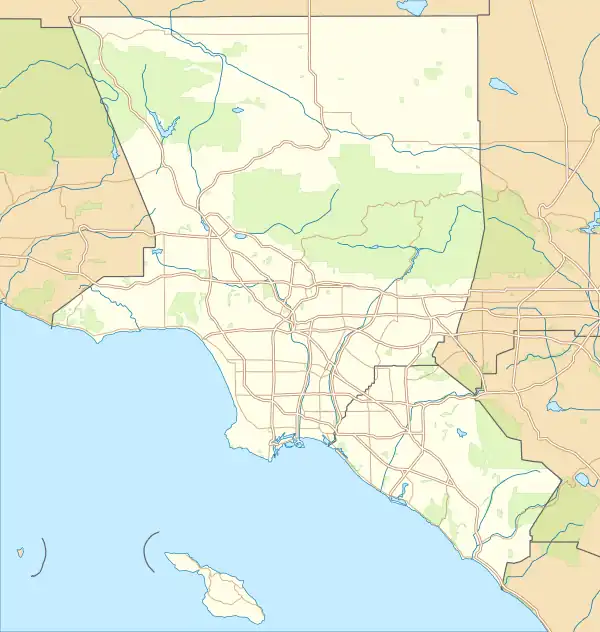Equitable Building of Hollywood
Equitable Building of Hollywood, also known as the Bank of Hollywood Building,[2] was the second high-rise office building built at the intersection of Hollywood and Vine in Hollywood, California.[3][4][2] It is rendered in a late Gothic Revival and Art Deco style and[2] is Los Angeles Historic-Cultural Monument #1088. It is also a contributor to the Hollywood Boulevard Commercial and Entertainment District on the National Register of Historic Places.[2]
Equitable Building of Hollywood | |
 The building in 2014 | |
| Location | 6253 W. Hollywood Blvd Hollywood, California |
|---|---|
| Coordinates | 34.1020°N 118.3263°W |
| Built | 1929, 1931 |
| Architect | Alex Curlett |
| Architectural style | Gothic Revival, Art Deco |
| Part of | Hollywood Boulevard Commercial and Entertainment District (ID85000704) |
| LAHCM No. | 1088 |
| Significant dates | |
| Designated CP | April 4, 1985 |
| Designated LAHCM | May 13, 2015[1] |
History
The Equitable Building was envisioned as part of The Five-Finger Plan, an infrastructure plan that made use of both public and private funds to "metropolitanize" Hollywood as an urban core.[2] It was designed by architect Alex Curlett[2] and built in two phases. The first phase was undertaken in 1929, which created 27,800 sq ft (2,580 m2) of office space above the ground floor, which housed retail businesses and the Bank of Hollywood.[2][5] The second phase of construction took place in 1931,[2] at which point Myron Selznick, brother of David O. Selznick, moved his agency into the building.[6] Kenneth P. Butler's Butler Health Institute also began a lease around this time, occupying the entire roof and twelfth story with "tiled steam rooms, showers, private toilet facilities, separate treatment rooms, [and] exercising rooms."[2] The headquarters of Marian Nixon's Beauty Arts Institute also occupied space in the building.[2] In April 1931, the Jassby Drug Company entered a long-term lease for space on the building's ground floor.[2]
The first floor at one time housed Bernard Luggage, Oshkosh Luggage, and other businesses.[7] From the 1950s through the 1970s, storefronts and interior public spaces were modernized, including a front entrance redesign, while between 1999 and 2001, exterior and main lobby alterations were remediated and original features were reconstructed.[2]
As of 2004, the building's upper stories have been converted to residential use, with 60 units' worth of condos designed by Kenneth Brown and Pamela Shamshiri.[8][2][9] Circa 2011, the architectural M2A held office space in the lower retail space.[10]
References
- "Historic-Cultural Monument (HCM) List" (PDF). Retrieved Oct 10, 2020.
- "Recommendation report" (PDF). planning.lacity.org. March 19, 2015. Retrieved 2020-10-02.
- "The Equitable Building of Hollywood". hollywoodheritage.com.
- "Corner of Hollywood and Vine". Calisphere.
- Masters, Nathan (August 30, 2013). "Photos: From Prospect & Weyse to Hollywood & Vine". KCET.
- "That Building on the Corner of Hollywood & Vine". January 3, 2018.
- "Equitable Building, Hollywood, 1954 :: Los Angeles Examiner Photographs Collection, 1920-1961". digitallibrary.usc.edu.
- "Taft Building, an aging Hollywood hot spot, gets a makeover". Los Angeles Times. January 29, 2015.
- "Hollywood makeover". Los Angeles Times. July 19, 2007.
- "PCAD - Equitable Building, Hollywood, Los Angeles, CA". pcad.lib.washington.edu.


